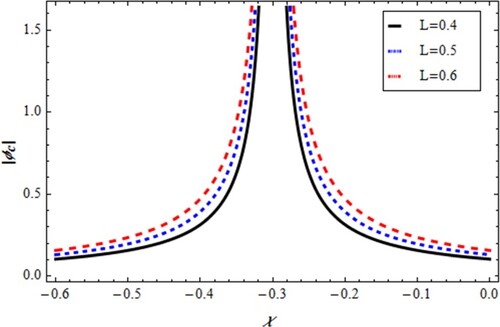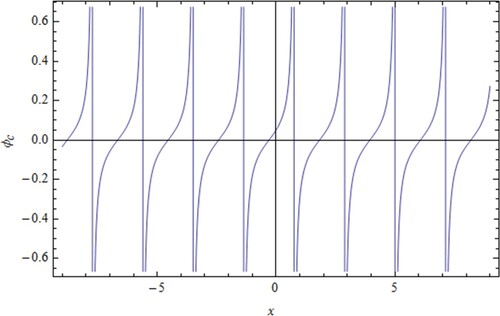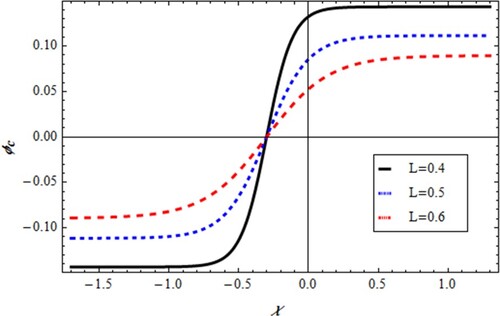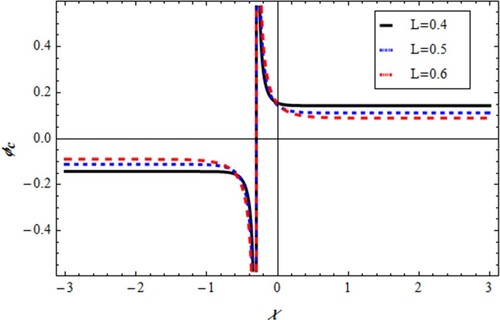 ?Mathematical formulae have been encoded as MathML and are displayed in this HTML version using MathJax in order to improve their display. Uncheck the box to turn MathJax off. This feature requires Javascript. Click on a formula to zoom.
?Mathematical formulae have been encoded as MathML and are displayed in this HTML version using MathJax in order to improve their display. Uncheck the box to turn MathJax off. This feature requires Javascript. Click on a formula to zoom.Abstract
The mathematical new plasma wave solutions are specified in the compose of trigonometric, rational, hyperbolic, periodic and explosive kinds that are realistic for Modified-Kadomtsev-Petviashvili (MKP) equation. Also, numeral studies for the acquired solutions have been reveals that periodic, shock and explosive new forms may applicable in D-F Earth's ionosphere plasma. The used method is influential and robust in comparison applications in plasma fluids. To depict the propagating soliton profiles in a plasma medium, it is needful to solve MKP equation at a critical mass ratio. The Riccati–Bernoulli sub-ODE technique has been utilized to introduce some new important and applicable solutions. The number of these MKP solutions give a leading deed in applied ion acoustics in ionosphere.
1. Introduction
The existence of the ion-acoustic solitary excitations (IAs) in plasmas has been spotted in laboratory [Citation1–5]. Different observations in space assured the IAs propagations in magnetospheres and ionosphere [Citation6–10]. The ion pairs electrostatic oscillations were conceived by Oohara and Hatakeyama by using fullerenes [Citation11,Citation12]. Saleem studied the plasma quasineutrality in pair ion-acoustic nonlinear dynamical properties [Citation13]. Sabry et al. [Citation14] used nonthermal properties of electron to discuss the ion wave formation characteristics in pair plasma. On the other hand, the progress of rogue ion-acoustic behaviours in many distributed electrons have been investigated [Citation15,Citation16]. Generally, many theoretical studies in solitary applications in natural science and space have been reported [Citation16–26].
Consider the nonlinear partial differential equation
(1)
(1) for an unknown function
. Utilizing the wave transformation
(2)
(2) Equation (Equation1
(1)
(1) ) converted to the following ODE:
(3)
(3) There are so many models in physics, fluid mechanics and engineering fields in forms of partial differential Equation (Equation1
(1)
(1) ) are transformed into the following ODE:
(4)
(4) see for example [Citation27–39]. This observation gives this equation special and important feature. Due to the importance of Equation (Equation3
(3)
(3) ), we pose the robust and unified solver for the widely used NPDEs, utilizing RB sub-ODE method [Citation40]. Namely, RB sub-ODE method [Citation40] is the basic ingredient for this solver. This solver can be used as a box solver for solving so many equations arising in applied science. This solver will be so helpful for engineers, physicists and mathematicians in order to emphasis some interesting phenomena in real-life problems.
2. The RB sub-ODE method
According to RB sub-ODE method [Citation40], the solution of Equation (Equation3(3)
(3) ) is
(5)
(5) where a, b, c and n are constants determined later. Equation (Equation5
(5)
(5) ) gives
(6)
(6)
(7)
(7) The solitary solutions
of Equation (Equation5
(5)
(5) ) are
For m = 1
(8)
(8)
For
, b = 0 and c = 0
(9)
(9)
For
,
and c = 0
(10)
(10)
For
,
and
(11)
(11) and
(12)
(12)
For
,
and
(13)
(13) and
(14)
(14)
For
,
and
(15)
(15)
2.0.1. Bäcklund transformation
If and
are the solutions of Equation (Equation5
(5)
(5) ), we have
namely
(16)
(16) Integrating Equation (Equation16
(16)
(16) ) once with respect to ξ, yields a Bäcklund transformation of Equation (Equation5
(5)
(5) ) as follows:
(17)
(17) where
and
are arbitrary constants. Equation (Equation17
(17)
(17) ) gives the infinite solutions of Equation (Equation5
(5)
(5) ), as well of Equation (Equation1
(1)
(1) ).
3. Unified solver
In this section, we will see how the concept of a unified solver is in practice implemented.
(18)
(18) using RB sub-ODE method. Substituting Equations (Equation6
(6)
(6) ) into Equation (Equation18
(18)
(18) ), we obtain
(19)
(19) Putting m = 0, Equation (Equation19
(19)
(19) ) is reduced to
(20)
(20) Setting each coefficient of
to zero, we get
(21)
(21)
(22)
(22)
(23)
(23)
(24)
(24) Solving Equations (Equation21
(21)
(21) )–(Equation24
(24)
(24) ), yields
(25)
(25)
(26)
(26)
(27)
(27) Hence, we give the cases of solutions for Equations (Equation18
(18)
(18) ) and (Equation1
(1)
(1) ), respectively
When b = 0 and
, the solution of Equation (Equation18
(18)
(18) ) is
(28)
(28) where ς is arbitrary constant.
When
, substituting Equations (Equation25
(25)
(25) )– (Equation27
(27)
(27) ) and (Equation2
(2)
(2) ) into Equations (Equation11
(11)
(11) ) and (Equation12
(12)
(12) ), then the trigonometric function solutions of Equation (Equation1
(1)
(1) ) are
(29)
(29) and
(30)
(30) where ς is arbitrary constant.
When
, substituting Equations (Equation25
(25)
(25) )–(Equation27
(27)
(27) ) and (Equation2
(2)
(2) ) into Equations (Equation13
(13)
(13) ) and (Equation14
(14)
(14) ), then the hyperbolic function solutions of Equation (Equation1
(1)
(1) ) are,
(31)
(31) and
(32)
(32) where ς is arbitrary constant.
4. Mathematical model
Using stretched where ε is a very small value and λ is the IA speed. Sabry et al. [Citation17] examined the propagating IAWs in plasma having negative and positive fluids in addition to electrons. In the case of Maxwillian electrons, Poisson's equation reads,
(33)
(33) Where
is the number density of heavy negative ions, light positive ions normalized by its equilibrium value
,
is the negative (positive) ion fluid velocity, the electrostatic potential φ. With
and
are the unperturbed negative ion and electron to positive ion ratio, respectively. Thus, the equilibrium condition implies
is the mass ratio, where
is the heavy (light) ion fluid mass,
where
is charge numbers. The obtained results support that the system becomes at critical at
, the modified KP equation was given:
(34)
(34) with
(35)
(35)
(36)
(36) By using a similarity transformation given in the form:
(37)
(37)
(38)
(38)
(39)
(39) where L and M are the directional cosines of x- and y -axes.
The modified KP form transformed into the ODE in the form:
(40)
(40) Equation (Equation40
(40)
(40) ) gives stationary soliton in the form
(41)
(41)
(42)
(42)
(43)
(43) where u and v are the travelling speed in the two directions.
5. Results and discussion
Comparing Equation (Equation40(40)
(40) ) with the general form (Equation18
(18)
(18) ), gives
,
and
. According to the unified solver given in Section 3, the solutions of Equation (Equation40
(40)
(40) ) are:
Rational function solutions: (when )
The rational solutions of Equation (Equation40(40)
(40) ) are
(44)
(44) Trigonometric function solution: (When
)
The trigonometric solutions of Equation (Equation40(40)
(40) ) are
(45)
(45) and
(46)
(46) Hyperbolic function solution : (When
)
The hyperbolic solutions of Equation (Equation41(41)
(41) ) are
(47)
(47) and
(48)
(48) Two-dimensional propagation of MKP solitary nonlinear IAs have been examined in a plasma mode using parameters related to the plasmas of Earth's ionosphere [Citation16,Citation17]. At certain mass ratio value called the criticality value, the obtained equation cannot describe mode. So, new stretching produced MKP equation which describes critical system under investigation. Equation (Equation42
(42)
(42) ) represents soliton with stationary behaviour at different directionalcosine in x-axis (L) as shown in Figure . At a critical point, many solitary forms were expected to discuss the IAs behaviour using Riccati–Bernoulli solver for MKP equation. Solution (Equation45
(45)
(45) ) is solitonic wave type called explosive type with rapid increasing amplitude as depicted in Figure . Solution (Equation46
(46)
(46) ) is blow-up periodic shape as in Figure . On the other hand, the dissipative behaviours are also produced in Figures and . In the solution of (Equation48
(48)
(48) ), the shock wave is propagated in the medium as shown in Figure . Finally, the explosive shock profile is obtained for solution (49) as shown in Figure .
6. Conclusions
Riccati–Bernoulli solver gives new solitary excitations for MKP equation such as periodic, explosive, shock and new explosive shocks which represent the pictures of wave motion of plasma solitons. It was reported that the obtained forms can be used in verify the broadband and magnetotail electrostatic waves observations.
Acknowledgements
This project was supported by the deanship of scientific research at Prince Sattam Bin Abdulaziz University under the research project No. 10259/01/2019.
Disclosure statement
No potential conflict of interest was reported by the author(s).
References
- Tran MQ. Ion acoustic solitons in a plasma: a review of their experimental properties and related theories. Phys Scr. 1979;20(3-4):317–327. doi: 10.1088/0031-8949/20/3-4/004
- Nakamura Y, Ferreira JL, Ludwig GO. Experiments on ion-acoustic rarefactive solitons in a multi-component plasma with negative ions. J Plasma Phys. 1985;33(2):237–248. doi: 10.1017/S0022377800002476
- Nakamura Y, Odagiri T, Tsukabayashi I. Ion-acoustic waves in a multicomponent plasma with negative ions. Plasma Phys Control Fusion. 1997;39:105–115. doi: 10.1088/0741-3335/39/1/007
- Nakamura Y, Tsukabayashi I. Observation of modified korteweg-de vries solitons in a multicomponent plasma with negative ions. Phys Rev Lett. 1984;52:2356. doi: 10.1103/PhysRevLett.52.2356
- Lonngren KE. Soliton experiments in plasmas. Plasma Phys. 1983;25:943–982. doi: 10.1088/0032-1028/25/9/001
- Popel SI, Vladimirov SV, Shukla PK. Ion-acoustic solitons in electron-positron-ion plasmas. Phys Plasmas. 1995;2:716. doi: 10.1063/1.871422
- Roy K, Misra AP, Chatterjee P. Ion-acoustic shocks in quantum electron-positron-ion plasmas. Phys Plasmas. 2008;15:032310. doi: 10.1063/1.2896231
- Gill TS, Bedi C, Bains AS. Envelope excitations of ion acoustic solitary waves in a plasma with superthermal electrons and positrons. Phys Scripta. 2010;81(5):055503. doi: 10.1088/0031-8949/81/05/055503
- Williams G, Verheest F, Hellberg MA, et al. A Schamel equation for ion acoustic waves in superthermal plasmas. Phys Plasmas. 2014;21:092103. doi: 10.1063/1.4894115
- Sahu B. Nonplanar ion acoustic waves in collisional quantum plasma. Phys A: Statist Mechanics Its Applications. 2018;509:162–168. doi: 10.1016/j.physa.2018.06.028
- Oohara W, Hatakeyama R. Pair-ion plasma generation using fullerenes. Phys Rev Lett. 2003;91:205005. doi: 10.1103/PhysRevLett.91.205005
- Oohara W., Date D., Hatakeyama R. Electrostatic waves in a paired fullereneion plasma. Phys Rev Lett. 2005;95:175003. doi: 10.1103/PhysRevLett.95.175003
- Saleem H. A criterion for pure pair-ion plasmas and the role of quasineutrality in nonlinear dynamics. Phys Plasmas. 2007;14:014505.
- Sabry R, Moslem WM, Shukla PK. Fully nonlinear ion-acoustic solitary waves in a plasma with positive-negative ions and nonthermal electrons. Phys Plasmas. 2009;16:032302.
- Elwakil SA, El-Shewy EK, Abdelwahed HG. Envelope ion-acoustic solitary waves in a plasma with positive-negative ions and nonthermal electrons. Phys Plasmas. 2010;17:052301. doi: 10.1063/1.3383052
- Abdelwahed HG, El-Shewy EK, Zahran MA, et al. On the rogue wave propagation in ion pair superthermal plasma. Phys Plasmas. 2016;23:022102.
- Abdelwahed HG, El-Shewy EK, El-Rahman AA, et al. Cylindrical shock waves in space superthermal fluids. J Korean Phys Soc. 2019;75(9):693–698. doi: 10.3938/jkps.75.693
- Aliyu AI, Li Y, Qi L. Lump-type and bell-shaped soliton solutions of the time-dependent coefficient Kadomtsev-Petviashvili equation. Front Phys. 2020;7:242. doi: 10.3389/fphy.2019.00242
- Abdo NF. Effect of non Maxwellian distribution on the dressed electrostatic wave and energy properties. J Taibah University Sci. 2017;11:617–622. doi: 10.1016/j.jtusci.2016.06.001
- El-Shewy EK, Abdelwahed HG, Abdo NF, et al. On the modulation of ionic velocity in electron-positron-ion plasmas. J Taibah University Sci. 2017;11:1267–1274. doi: 10.1016/j.jtusci.2017.03.003
- Ghanbari B, Gómez-Aguilar JF. New exact optical soliton solutions for nonlinear Schrödinger equation with second-order spatio-Temporal dispersion involving M-derivative. Modern Phys Lett B. 2019;33(20):1950235. doi: 10.1142/S021798491950235X
- Ghanbari B, Baleanu D. New solutions of Gardner's equation using two analytical methods. Front. Phys. 2019. doi:10.3389/fphy.2019.00202.
- Ghanbari B, Baleanu D. A novel technique to construct exact solutions for nonlinear partial differential equations. Eur Phys J Plus. 2019;134:506. doi:10.1140/epjp/i2019-13037-9.
- Srivastava HM, Günerhan H, Ghanbari B. Exact traveling wave solutions for resonance nonlinear Schrödinger equation with intermodal dispersions and the Kerr law nonlinearity. Math Methods Appl Sci. 2019;42:7210–7221. doi: 10.1002/mma.5827
- Ghanbari B, Kuo C. New exact wave solutions of the variable-coefficient (1 + 1)-dimensional Benjamin-Bona-Mahony and (2 + 1)-dimensional asymmetric Nizhnik-Novikov-Veselov equations via the generalized exponential rational function method. Eur Phys J Plus. 2019;134:334. doi:10.1140/epjp/i2019-12632-0.
- Ghanbari B, Inc M, Rada L. Solitary wave solutions to the Tzitzeica type equations obtained by a new efficient approach. J Appl Anal Comput. 2019;9(2):568–89.
- Abdelrahman MAE, Sohaly MA. The development of the deterministic nonlinear PDEs in particle physics to stochastic case. Results Phys. 2018;9:344–350. doi: 10.1016/j.rinp.2018.02.032
- Abdelrahman MAE. A note on Riccati-Bernoulli sub-ODE method combined with complex transform method applied to fractional differential equations. Nonlinear Eng Model Appl. 2018;7(4):279–285. doi: 10.1515/nleng-2017-0145
- Abdelrahman MAE, Sohaly MA. On the new wave solutions to the MCH equation. Indian J Phys. 2019;93:903–911. doi: 10.1007/s12648-018-1354-6
- Abdelrahman MAE, Sohaly MA. Solitary waves for the nonlinear Schrödinger problem with the probability distribution function in stochastic input case. Eur Phys J Plus. 2017;132:339. doi: 10.1140/epjp/i2017-11607-5
- Abdelrahman MAE, Moaaz O. New exact solutions to the dual-core optical fibers. Indian J Phys. 2019. doi:10.1007/s12648-019-01503-w.
- Hassan SZ, Abdelrahman MAE. Solitary wave solutions for some nonlinear time fractional partial differential equations. Pramana-J Phys. 2018;91:67. doi: 10.1007/s12043-018-1636-8
- Wazwaz AM. A sine-cosine method for handling nonlinear wave equations. Math Comput Modelling. 2004;40:499–508. doi: 10.1016/j.mcm.2003.12.010
- Baskonus HM, Bulut H. New wave behaviors of the system of equations for the ion sound and Langmuir waves. Waves Random Complex Media. 2016;26:613–625. doi: 10.1080/17455030.2016.1181811
- Liu C. Exact solutions for the higher-order nonlinear Schrödinger equation in nonlinear optical fibres. Chaos, Solitons and Fractals. 2005;23:949–955. doi: 10.1016/S0960-0779(04)00345-5
- Zhang S. Exp-function method for solving Maccari's system. Phys Lett A. 2007;371:65–71. doi: 10.1016/j.physleta.2007.05.091
- El Achab A, Amine A. A construction of new exact periodic wave and solitary wave solutions for the 2D Ginzburg-Landau equation. Nonlinear Dyn. 2017. doi:10.1007/s11071-017-3924-0.
- Hosseini K, Kumar D, Kaplan M, et al. New exact traveling wave solutions of the unstable nonlinear Schrödinger equations. Commun Theor Phys. 2017c;68:761–767. doi: 10.1088/0253-6102/68/6/761
- Bulut H, Sulaiman TA, Baskonus HM. Optical solitons to the resonant nonlinear Schrödinger equation with both spatio-temporal and inter-modal dispersions under Kerr law nonlinearity. Optik. 2018;163:49–55. doi: 10.1016/j.ijleo.2018.02.081
- Yang XF, Deng ZC, Wei Y. A Riccati-Bernoulli sub-ODE method for nonlinear partial differential equations and its application. Adv Diff Equ;1:117–133.





